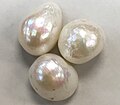File:Pearls 2.jpg

Original file (2,705 × 2,359 pixels, file size: 1.82 MB, MIME type: image/jpeg)
| This is a file from the Wikimedia Commons. Information from its description page there is shown below. Commons is a freely licensed media file repository. You can help. |
Summary
| DescriptionPearls 2.jpg |
English: (the pearl at right is ~1.4 centimeters across at its widest)
(photo by Tyler Houck) Pearls are spherical to subspherical to irregularly-shaped, biogenic concretions of slightly iridescent, nacreous aragonite (CaCO3 - calcium carbonate). Pearls are principally made by pearl oysters (Animalia, Mollusca, Bivalvia). Natural pearls are scarce. Well-formed, spherical natural pearls are rare. Fossil pearls are known, but are also scarce. "Mother of pearl" is relatively common - the same material in pearls occurs in the actual shells of some bivalves. Well-known pearl oysters include Pinctada margaritifera (the black-lipped pearl oyster), Pinctada fucata (the Japanese pearl oyster), and Pinctada maxima (the gold-lipped pearl oyster). Mother-of-pearl is well developed in shells of other species such as Pinctada imbricata (Atlantic pearl oyster), Pteria colymbus, Pteria penguin (both are winged pearl oysters), Haliotis spp. (abalones), and Atrina spp. (pen shells). Natural pearls form when foreign objects, such as sediment grains or other debris, enter a pearl oyster and get embedded in its mantle tissue. The particle is slowly coated with nacreous aragonite, which prevents the particle from causing disease or injury. The end result is a biogenic concretion called a pearl. Natural pearls show a concentric structure through the entire cross-section. Almost all commercially available pearls are semi-natural - they have been cultured. Cultured pearls have been available for many decades. A spherical bead is placed inside a pearl oyster, under its mantle tissue. The bead is slowly coated with nacreous aragonite to produce a cultured pearl, which shows concentric structure only in the outer portions of its cross-section. Marine pearls can be whitish, pinkish, yellowish, or blackish. Freshwater pearls are also known - natural examples vary from ~spherical to highly irregularly-shaped. Blister pearls are attached to the host mollusc's shell. See info. at: en.wikipedia.org/wiki/Pearl |
| Date | |
| Source | https://www.flickr.com/photos/47445767@N05/49554801623/ |
| Author | James St. John |
Licensing
- You are free:
- to share – to copy, distribute and transmit the work
- to remix – to adapt the work
- Under the following conditions:
- attribution – You must give appropriate credit, provide a link to the license, and indicate if changes were made. You may do so in any reasonable manner, but not in any way that suggests the licensor endorses you or your use.
| This image was originally posted to Flickr by James St. John at https://flickr.com/photos/47445767@N05/49554801623 (archive). It was reviewed on 20 February 2020 by FlickreviewR 2 and was confirmed to be licensed under the terms of the cc-by-2.0. |
20 February 2020
Captions
Items portrayed in this file
depicts
some value
12 February 2020
0.025 second
2.2
4.15 millimetre
File history
Click on a date/time to view the file as it appeared at that time.
| Date/Time | Thumbnail | Dimensions | User | Comment | |
|---|---|---|---|---|---|
| current | 19:23, 20 February 2020 |  | 2,705 × 2,359 (1.82 MB) | Ser Amantio di Nicolao | User created page with UploadWizard |
File usage
The following page uses this file:
Global file usage
The following other wikis use this file:
- Usage on no.wikipedia.org
Metadata
This file contains additional information, probably added from the digital camera or scanner used to create or digitize it.
If the file has been modified from its original state, some details may not fully reflect the modified file.
| Camera manufacturer | Apple |
|---|---|
| Camera model | iPhone SE |
| Exposure time | 1/40 sec (0.025) |
| F-number | f/2.2 |
| ISO speed rating | 25 |
| Date and time of data generation | 17:51, 12 February 2020 |
| Lens focal length | 4.15 mm |
| Width | 3,024 px |
| Height | 4,032 px |
| Bits per component |
|
| Pixel composition | RGB |
| Orientation | Normal |
| Number of components | 3 |
| Horizontal resolution | 72 dpi |
| Vertical resolution | 72 dpi |
| Software used | Adobe Photoshop Elements 16.0 (Macintosh) |
| File change date and time | 23:26, 18 February 2020 |
| Y and C positioning | Centered |
| Exposure Program | Normal program |
| Exif version | 2.21 |
| Date and time of digitizing | 17:51, 12 February 2020 |
| Meaning of each component |
|
| Shutter speed | 5.322390019698 |
| APEX aperture | 2.2750071245369 |
| APEX brightness | 5.2328854766475 |
| Exposure bias | 0 |
| Metering mode | Spot |
| Flash | Flash did not fire, compulsory flash suppression |
| DateTimeOriginal subseconds | 103 |
| DateTimeDigitized subseconds | 103 |
| Supported Flashpix version | 1 |
| Color space | sRGB |
| Sensing method | One-chip color area sensor |
| Scene type | A directly photographed image |
| Exposure mode | Auto exposure |
| White balance | Auto white balance |
| Digital zoom ratio | 1.7581395348837 |
| Focal length in 35 mm film | 51 mm |
| Scene capture type | Standard |
| Lens used | iPhone SE back camera 4.15mm f/2.2 |
| Date metadata was last modified | 18:26, 18 February 2020 |
| Unique ID of original document | CF33FE4C4C1FB4C4E1068A871C18DA74 |
